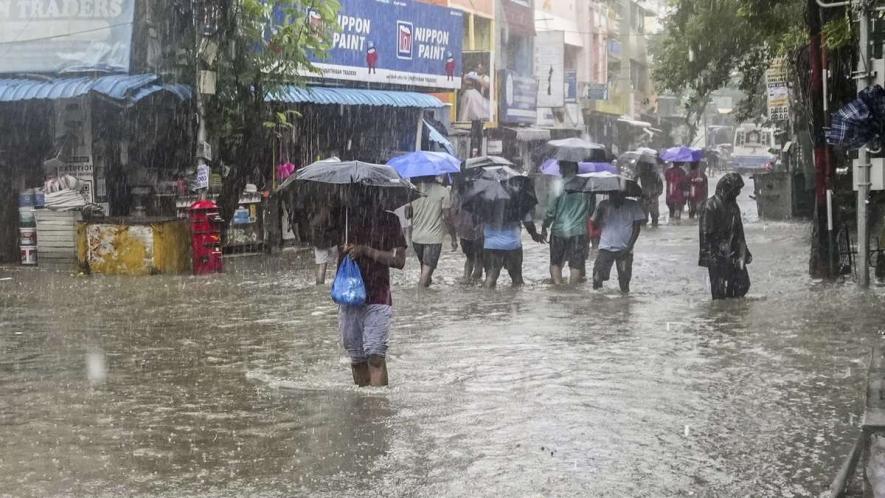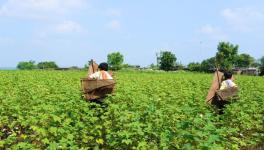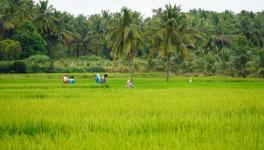Cyclone Michaung: Insufficient Drains, Shrinking Water Bodies Worsen Situation

Image courtesy: PTI
Cyclone Michaung flooded Chennai and its suburban areas, claiming 24 lives, inundating several lakh houses, disrupting power and telecommunication services, and halting air, rail, and road transport in the past week. It led to extensive damage to public and private property, bringing the city to a standstill from Monday onwards.
Life resumed as soon as the rains receded for those residing and working in places where water did not stagnate. However, that is not the case for those whose houses and workplaces were inundated by the rainwater.
After the 2015 heavy rains in Chennai, an audit conducted by the Indian Audit and Accounts Department cited the abandoning of lakes and the consequent reduction in the water storage capacity of the water bodies, and encroachment of tanks, lakes, and river beds as the primary reasons for the flooding.
The Audit report additionally cited inadequate coverage of stormwater drains (SWD) due to poor outlay coupled with improper design and missing links in the SWD networks adding to flooding. It also noted that the annual desilting works of waterways were not ensured before the onset of the monsoon.
The present DMK-led government in Tamil Nadu has ensured that stormwater drains are in place, but encroachments in low-lying areas have only grown in the past few years.
STORMWATER DRAINS NOT ENOUGH
It seems that due to the SWD works carried out in the past two years, rainwater drained fast on the main roads and many residential localities after the rains stopped, and the traffic was smooth. However, stormwater drains were unable to drain out water from the low-lying areas.
Cyclone Michaung has belied the claims made by the Tamil Nadu CM and the Chennai mayor. They had said earlier that the SWD works carried out in Chennai over the past few months could enable the city to handle any amount of rainwater.
The rainwater from the western part of Chennai flowed through the Koovam and Adyar rivers, flooding the low-lying areas of the city. The excess water was unable to reach the sea and flooded localities of south Chennai such as Tambaram, Mudichur, Velachery, Tharamani, Karapakkam, Sholinganallur, Thiruvanmiyur, Pallikaranai, and Perumbakkam for two days.
It is unfortunate that the plight of the low-lying areas, as in 2015, repeated this year. Even after the rains stopped, the people suffered without running water, electricity, and food.
Poovulagin Nanbargal, an environmental organisation, said given that 2023 is recognised as an El Niño year with erratic climate events, “we should have expected heavy rains and taken appropriate precautions,” and that extreme climatic disasters cannot be tackled by SWD projects alone.
Tamil Nadu ranks 7th among the states of India most affected and likely to be affected by the impact of climate change. The state needs to take larger measures.
‘TAKE CLIMATE CHANGE INTO ACCOUNT’
Various studies have indicated an increase in the intensity of storms in the Bay of Bengal and an increase in the number of storms in the Arabian Sea. It is established that the reason for this is the increase in sea surface temperature in the north of the Indian Ocean due to global warming.
The Intergovernmental Panel on Climate Change (IPCC) has warned that extreme disasters, which earlier occurred once in 100 years, may now occur once a year. The Climate Studio established at Anna University predicts that Chennai’s annual average rainfall will increase by 20%, with extreme rainfall days (6.5 cm+) expected to double. According to the Chennai Climate Change Action Plan report, 46% of Chennai will be inundated by a once-in-25-year flood.
“The heavy rains in 2015 and the damage caused by the negligence of the then AIADMK government have taught us various lessons. The important lesson is that we need to build our cities to face the serious effects of climate change,” stated Poovulagin Nanbargal. At present, on average, 28,000 people live in one sq km of Chennai, compared to just 11,000 people per sq km of the planned and developed city New York.
Studies confirm that the impact of climate change will intensify in Chennai, Tiruvallur, Kanchipuram, and Chengalpattu; these districts need to increase their adaptive capacity to protect them from the impact of storms. Redefining the land use of these areas is very necessary to prepare for severe climate disasters and not just think of short-term solutions for heavy rains.
ENCROACHMENTS IN WATER BODIES
Shrinking lakes, marshlands, agricultural land, and fallow land due to unrestrained encroachments has blocked the free flow of floodwater and inundated several parts of the city, according to reports. The Chennai Metropolitan Development Authority (CMDA) failed to ensure the regulated development of the city and planned land use patterns. The sudden drop in water catchment areas has resulted in adverse congestion, environmental degradation, and flooding, according to environmental groups.
“Pallikaranai marshland in south Chennai, which was 13,500 acres, has now been reduced to 1,500 acres. The role of Pallikaranai marshland in collecting Chennai's rainwater and sending excess water to the sea is very high,” noted the NGO Arappor Iyakkam.
“Overflowing water from the Pallavaram, Keelkattalai, and Narayanapuram lakes reaches the Pallikaranai marshland. The rainwater from this marshland reaches the Buckingham Canal through links and joins the sea at Muttukadu,” it stated and added that the shrinking marshland has gravely affected water management in south Chennai.
While it may be true that the growth of Chennai has boosted the economy of Tamil Nadu, many argue that it has been built at the cost of the destruction of existing water bodies like tanks, lakes, ponds, and canals, which caused the flood, noted Poovulagin Nanbargal.
NGOs, activists, and civil society organisations contend that the people who lost possessions and livelihoods in the 2015 floods were still reeling from their misery; the government needs to undertake transparent urban planning.
At present, the Greater Chennai Corporation is involved in clearing water stagnation around the city and controlling the spread of diseases. Many have complained about drainage water stagnating on roads and on vacant plots, which are becoming breeding grounds for insects, reptiles, rodents, and worms.
In the past seven to eight years, especially in 2015, a large number of new flats have been built in the low-lying areas (most of which are government constructions including Government Slum Replacement Board flats) which shows us the complacency and indifference towards disaster adaptation on all sides.
Experts believe that the government needs to re-examine the projects, including Parantur Airport and the expansion of Chennai, as various global studies have shown that the intensity and number of disasters will increase in the future. It may be noted here that the area selected for Parantur airport expansion is affected by current floods.
Get the latest reports & analysis with people's perspective on Protests, movements & deep analytical videos, discussions of the current affairs in your Telegram app. Subscribe to NewsClick's Telegram channel & get Real-Time updates on stories, as they get published on our website.
























